Paleoenvironment Implication of Red Paleosols in a Late Cretaceous Continental Succession, Songliao Basin, NE China
Abstract
:1. Introduction
2. Geological Setting
3. Methods
4. Results
4.1. Facies Description and Interpretation
4.1.1. Facies 1
Description
Interpretation
4.1.2. Facies 2
Description
Interpretation
4.1.3. Facies 3
Description
Interpretation
4.2. Elemental Geochemistry Characteristics of the Red Bed Sucssion with Paleosols
5. Discussions
5.1. Paleoenvironmental Transition of the Paleosols
5.2. Tectonic Uplift Events Inferred from the Paleosols
6. Conclusions
Author Contributions
Funding
Data Availability Statement
Acknowledgments
Conflicts of Interest
References
- Alonso-Zarza, A.M.; Zhao, Z.; Song, C.H.; Li, J.J.; Zhang, J.; Martín-Pérez, A.; Martín-García, R.; Wang, X.X.; Zhang, Y.; Zhang, M.H. Mudflat/distal fan and shallow lake sedimentation (upper Vallesian-Turolian) in the Tianshui basin, central China: Evidence against the late Miocene eolian loess. Sediment. Geol. 2009, 222, 42–51. [Google Scholar] [CrossRef] [Green Version]
- Aziz, H.A.; Sans-Rubio, E.; Calvo, J.P.; Hilgen, F.J.; Krijgsman, W. Palaeoenvironmental reconstruction of a middle Miocene alluvial fan to cyclic shallow lacustrine depositional system in the Calatayud Basin (NE Spain). Sedimentology 2003, 50, 211–236. [Google Scholar] [CrossRef] [Green Version]
- Basilici, G.; Bo, P.F.D.; De Oliveira, E.F. Distribution of palaeosols and deposits in the temporal evolution of a semiarid fluvial distributary system (Bauru Group, Upper Cretaceous, SE Brazil). Sediment. Geol. 2016, 341, 245–264. [Google Scholar] [CrossRef]
- Bice, K.L.; Birgel, D.; Meyers, P.A.; Dahl, K.A.; Hinrichs, K.U.; Norris, R.D. A multiple proxy and model study of Cretaceous upper ocean temperatures and atmospheric CO2 concentrations. Paleoceanography 2006, 21, PA2002. [Google Scholar] [CrossRef] [Green Version]
- Brewer, R. Fabric and Mineral Analysis of Soils. Robert, E., Ed.; Krieger Publishing Company: New York, NY, USA, 1976; pp. 434–444. [Google Scholar]
- Cao, H.; Guo, W.; Shan, X.; Ma, L.; Sun, P. Paleolimnological environments and organic accumulation of the Nenjiang Formation in the southeastern Songliao Basin. China Oil Shale 2015, 32, 5–24. [Google Scholar] [CrossRef] [Green Version]
- Catena, A.M.; Hembree, D.I.; Saylor, B.Z.; Anaya, F.; Croft, D.A. Paleoenvironmental analysis of the neotropical fossil mammal site of cerdas, Bolivia (middle Miocene) based on ichnofossils and paleopedology. Palaeogeogr. Palaeoclimatol. Palaeoecol. 2016, 459, 423–439. [Google Scholar] [CrossRef] [Green Version]
- Chamberlain, C.P.; Wan, X.; Graham, S.A.; Carroll, A.R.; Doebbert, A.C.; Sageman, B.B.; Blisniuka, P.; Kent-Corson, M.L.; Wang, Z.; Wang, C.S. Stable isotopic evidence for climate and basin evolution of the late Cretaceous Songliao Basin, China. Palaeogeogr. Palaeoclimatol. Palaeoecol. 2013, 385, 106–124. [Google Scholar] [CrossRef]
- Chen, J.; An, Z.; Wang, Y.; Ji, J.; Yang, C.; Lu, H. Distribution of rb and sr in the luochuan loess—paleosol sequence of china during the last 800 ka. Sci. China 1999, 42, 225–232. [Google Scholar] [CrossRef]
- Dal’Bó, P.F.F.; Basilici, G.; Angélica, R.S. Factors of paleosol formation in a Late Cretaceous eolian sand sheet paleoenvironment, Marília Formation, southeastern Brazil. Palaeogeogr. Palaeoclimatol. Palaeoecol. 2010, 292, 349–365. [Google Scholar] [CrossRef]
- Du, X.B.; Xie, X.N.; Lu, Y.C.; Ren, J.; Zhang, S.; Lang, P.; Chen, T.; Su, M.; Zhang, C. Distribution of continental red paleosols and their forming mechanisms in the Late Cretaceous Yaojia Formation of the Songliao Basin, NE China. Cretac. Res. 2011, 32, 244–257. [Google Scholar] [CrossRef]
- Feng, Z.Q.; Jia, C.Z.; Xie, X.N. Tectonostratigraphic units and stratigraphic sequences of the nonmarine Songliao Basin, Northeast China. Basin Res. 2010, 22, 79–95. [Google Scholar]
- Gao, Y.; Ibarra, D.E.; Wang, C.; Caves, J.K.; Chamberlain, C.P.; Graham, S.A.; Wu, H.C. Mid-latitude terrestrial climate of East Asia linked to global climate in the Late Cretaceous. Geology 2015, 43, 287–290. [Google Scholar] [CrossRef]
- Goldberg, K.; Humayun, M. The applicability of the chemical index of alteration as a paleoclimatic indicator; an example from the Permian of the Parana Basin, Brazil. Palaeogeogr. Palaeoclimatol. Palaeoecol. 2010, 293, 175–183. [Google Scholar] [CrossRef]
- Hatano, N.; Yoshida, K. Sedimentary environment and paleosols of middle Miocene fluvial and lacustrine sediments in central Japan: Implications for paleoclimate interpretations. Sediment. Geol. 2016, 347, 117–129. [Google Scholar] [CrossRef] [Green Version]
- Huang, C.M.; Retallack, G.J.; Wang, C.S. Cretaceous calcareous paleosols: Pedogenetic characteristics and paleoenvironmental implications. Acta Pedol. Sin. 2010, 47, 1029–1038. [Google Scholar]
- Jones, M.M.; Ibarra, D.E.; Gao, Y.; Sageman, B.B.; Selby, D.; Chamberlain, C.P.; Graham, S.A. Evaluating Late Cretaceous OAES and the influence of marine incursions on organic carbon burial in an expansive East Asian paleo-lake. Earth Planet. Sci. Lett. 2018, 484, 41–52. [Google Scholar] [CrossRef] [Green Version]
- Klappa, C.F. Rhizoliths in terrestrial carbonates: Classification, recognition, genesis, and significance. Sedimentology 1980, 27, 613–629. [Google Scholar] [CrossRef]
- Kottek, M.; Grieser, J.; Beck, C.; Rudolf, B.; Rubel, F. World map of the Köppen-Geiger climate classification updated. Meteorol. Z. 2006, 15, 259–263. [Google Scholar] [CrossRef]
- Kraus, M.J.; Hasiotis, S.T. Significance of different modes of rhizolith preservation to interpreting paleoenvironmental and paleohydrologic settings: Examples from Paleogene paleosols, Bighorn Basin, Wyoming, USA. J. Sediment. Res. 2006, 76, 633–646. [Google Scholar] [CrossRef]
- Li, C.; Liu, S.F. Cretaceous anomalous subsidence and its response to dynamic topography in the Songliao Basin, Northeast China. J. Asian Earth Sci. 2015, 109, 86–99. [Google Scholar] [CrossRef]
- Li, J.; Wen, X.Y.; Huang, C.M. Lower Cretaceous paleosols and paleoclimate in Sichuan basin, China. Cretac. Res. 2016, 62, 154–171. [Google Scholar] [CrossRef]
- Li, Z.D.; Zhang, L.S.; Were, P.; Wang, D.J. Sedimentary characteristics of 1st member of Yaojia formation in Zhaoyuan-Taipingchuan region of Songliao basin. J. Pet. Sci. Eng. 2017, 148, 52–63. [Google Scholar] [CrossRef]
- Maynard, J.B. Chemistry of modern soils as a guide to interpreting Precambrian paleosols. J. Geol. 1992, 100, 279–289. [Google Scholar] [CrossRef]
- Mc Lennan, S.M. Weathering and Global Denudation. J. Geol. 1993, 101, 295–303. [Google Scholar] [CrossRef]
- Mc Bride, E.F. Significance of color in red, green, purple, olive, brown, and gray beds of Difunta Group, Northeastern Mexico. J. Sediment. Res. 1974, 44, 760–773. [Google Scholar]
- Meng, Q.; Zhang, S.; Sun, G.; Fu, X.; Chao, W.; Yao, S. A seismic geomorphology study of the fluvial and lacustrine-delta facies of the Cretaceous Quantou-Nenjiang Formations in Songliao Basin, China. Mar. Pet. Geol. 2016, 78, 836–847. [Google Scholar]
- Owen, R.A.; Owen, R.B.; Renaut, R.W.; Scott, J.J.; Jones, B.; Ashley, G.M. Mineralogy and origin of rhizoliths on the margins of saline, alkaline lake Bogoria, Kenya rift valley. Sediment. Geol. 2008, 203, 143–163. [Google Scholar] [CrossRef]
- Pan, S.; Liang, S.; Ma, L.; Liu, C.; Liu, H. Genesis, distribution, and hydrocarbon implications of ostracod-bearing beds in the Songliao basin (NE China). Aust. J. Earth Sci. 2017, 64, 793–806. [Google Scholar] [CrossRef]
- Retallack, G.J. Pedogenic carbonate proxies for amount and seasonality of precipitation in paleosols. Geology 2005, 33, 333–336. [Google Scholar] [CrossRef]
- Retallack, G.J. The oldest known paleosol profiles on Earth: 3.46 Ga Panorama Formation, Western Australia. Palaeogeogr. Palaeoclimatol. Palaeoecol. 2018, 489, 230–248. [Google Scholar] [CrossRef]
- Retallack, G.J. Early forest soils and their role in Devonian global change. Science 1997, 276, 583–585. [Google Scholar] [CrossRef] [Green Version]
- Shao, L.Y.; He, Z.P.; Lu, J. Sequence Stratigraphy and Coal Accumulation of the Carboniferous and Permian in the Western Peri-Bohai Bay Area of the northern China; Geological Publishing House: Beijing, China, 2008; pp. 124–158. [Google Scholar]
- Sheldon, N.D.; Tabor, N.J. Quantitative paleoenvironmental and paleoclimatic reconstruction using paleosols. Earth Sci. Rev. 2009, 95, 1–52. [Google Scholar] [CrossRef]
- Sheldon, N.D.; Retallack, G.J.; Tanaka, S. Geochemical climofunctions from North American soils and application to palaeosols across the Eocene-Oligocene boundary in Oregon. J. Geol. 2002, 110, 687–696. [Google Scholar] [CrossRef] [Green Version]
- Skelton, P.W.; Spicer, R.A.; Kelley, S.P.; Gilmour, I. The Cretaceous World; Cambridge University Press: Cambridge, UK, 2003; pp. 1–12. [Google Scholar]
- Smith, J.J.; Hasiotis, S.T.; Kraus, M.J.; Woody, D.T. Relationship of floodplain ichnocoenoses to paleopedology, paleohydrology, and paleoclimate in the Willwood Formation, Wyoming, during the Paleocene-Eocene thermal maximum. Palaios 2008, 23, 683–699. [Google Scholar] [CrossRef]
- Smith, J.J.; Hasiotis, S.T.; Kraus, M.J.; Woody, D.T. Naktodemasis bowni: New ichnogenus and ichnospecies for adhesive meniscate burrows (AMB), and paleoenvironmental implications, Paleogene Willwood Formation, Bighorn Basin, Wyoming. J. Paleontol. 2008, 82, 267–278. [Google Scholar] [CrossRef]
- Soares, M.V.T.; Basilici, G.; Lorenzoni, P.; Colombera, L.; Mountney, N.P.; Martinelli, A.G.; Mesquita, Á.F.; Marinho, T.S.; García, R.G.V.; Marconato, A. Landscape and depositional controls on palaeosols of a distributive fluvial system (Upper Cretaceous, Brazil). Sediment. Geol. 2020, 410, 105774. [Google Scholar] [CrossRef]
- Song, Y.; Ren, J.; Stepashko, A.A.; Li, J. Post-rift geodynamics of the Songliao Basin, NE china: Origin and significance of T11 (Coniacian) unconformity. Tectonophysics 2014, 634, 1–18. [Google Scholar] [CrossRef]
- Therrien, F. Palaeoenvironments of the latest Cretaceous (Maastrichtian) dinosaurs of Romania: Insights from fluvial deposits and paleosols of the Transylvanian and Hateg basins. Palaeogeogr. Palaeoclimatol. Palaeoecol. 2005, 218, 15–56. [Google Scholar] [CrossRef]
- Varela, A.N.; Raigemborn, M.S.; Richiano, S.; White, T.; Poiré, D.G.; Lizzoli, S. Late Cretaceous paleosols as paleoclimate proxies of high-latitude southern hemisphere: Mata Amarilla formation, Patagonia, Argentina. Sediment. Geol. 2018, 363, 83–95. [Google Scholar] [CrossRef]
- Zaman, M.A.; Rahman, A.; Haddad, K. Regional flood frequency analysis in arid regions: A case study for Australia. J. Hydrol. 2012, 475, 74–83. [Google Scholar] [CrossRef]
- Zhang, L.; Bao, Z.D.; Lin, Y.; Chen, Y.; Dou, L.; Kong, B. Genetic types and sedimentary model of sandbodies in a shallow-water delta: A case study of the first Member of Cretaceous Yaojia Formation in Qian’an area, south of Songliao Basin, NE China. Pet. Explor. Dev. 2017, 44, 770–779. [Google Scholar] [CrossRef]
- Yang, L.J.; Shao, L.Y.; Zhang, P.F. Palaeosols: Types and recognition. Coal Geol. China 2002, 14, 1–3. [Google Scholar]
- Wan, X.Q.; Zhao, J.; Scott, R.W.; Wang, P.J.; Feng, Z.H.; Huang, Q.H.; Xi, D.P. Late Cretaceous stratigraphy, Songliao Basin, NE China: SK1 cores. Palaeogeogr. Palaeoclimatol. Palaeoecol. 2013, 385, 31–43. [Google Scholar] [CrossRef]
- Wang, C.S.; Scott, R.W.; Wan, X.Q.; Graham, S.A.; Huang, Y.J.; Wang, P.J.; Wu, H.C.; Dean, W.E.; Zhang, L.M. Late cretaceous climate changes recorded in Eastern Asian lacustrine deposits and North American epieric sea strata. Earth-Sci. Rev. 2013, 126, 275–299. [Google Scholar] [CrossRef]
- Wang, C.S.; Feng, Z.Q.; Zhang, L.M.; Huang, Y.; Cao, K.; Wang, P.; Zhao, B. Cretaceous paleogeography and paleoclimate and the setting of SKI borehole sites in Songliao Basin, northeast China. Palaeogeogr. Palaeoclimatol. Palaeoecol. 2013, 385, 17–30. [Google Scholar] [CrossRef]
- Wu, H.C.; Zhang, S.H.; Jiang, G.Q.; Hinnov, L.; Yang, T.; Li, H.; Wan, X.; Wang, C. Astrochronology of the Early Turonian-Early Campanian terrestrial succession in the Songliao Basin, northeastern China and its implication for long-period behavior of the Solar System. Palaeogeogr. Palaeoclimatol. Palaeoecol. 2013, 385, 55–70. [Google Scholar] [CrossRef]
- Xi, D.P.; Wan, X.Q.; Jansa, L. Late Cretaceous paleoenvironment and lake level fluctuation in the Songliao Basin, northeastern China. Isl. Arc 2011, 20, 6–22. [Google Scholar] [CrossRef]
- Xue, J.; Deng, Z.; Huang, P.; Huang, K.; Benton, M.J.; Cui, Y.; Wang, D.; Liu, J.; Shen, B.; Basinger, J.F.; et al. Belowground rhizomes in paleosols: The hidden half of an early Devonian vascular plant. Proc. Natl. Acad. Sci. USA 2016, 113, 9451–9456. [Google Scholar] [CrossRef] [Green Version]
- Yang, Y.T. An unrecognized major collision of the Okhotomorsk block with east Asia during the late Cretaceous, constraints on the plate reorganization of the northwest Pacific. Earth-Sci. Rev. 2013, 126, 96–115. [Google Scholar] [CrossRef]
- Zhang, L.M.; Wang, C.; Cao, K.; Wang, Q.; Tan, J.; Gao, Y. High elevation of Jiaolai Basin during the Late Cretaceous: Implication for the coastal mountains along the East Asian margin. Earth Planet. Sci. Lett. 2016, 456, 112–123. [Google Scholar] [CrossRef]
- Zhang, L.; Bao, Z.D.; Dou, L.; Wang, H.; Ji, Y. New Discovery of Red Paleosols with Calcite and Zeolitic Rhizoliths in the Late Cretaceous Yaojia Formation, Southern Songliao Basin, NE China. Acta Geol. Sin. 2018, 92, 2462–2463. [Google Scholar]
- Zhang, L.; Bao, Z.D.; Zhang, C.M.; Dou, L.X.; Fu, P.; Zhao, J.H.; Wang, W.X. Paleosols in an outcrop of red beds from the Upper Cretaceous Yaojia Formation, southern Songliao Basin, Jilin Province, NE China. J. Palaeogeogr. 2020, 3, 353–362. [Google Scholar] [CrossRef]
- Zhao, J. A new geological theory about eluvial zone-Theory illuvial on depth of CaCO3. Acta Sedimentol. Sin. 2000, 18, 29–35. [Google Scholar]

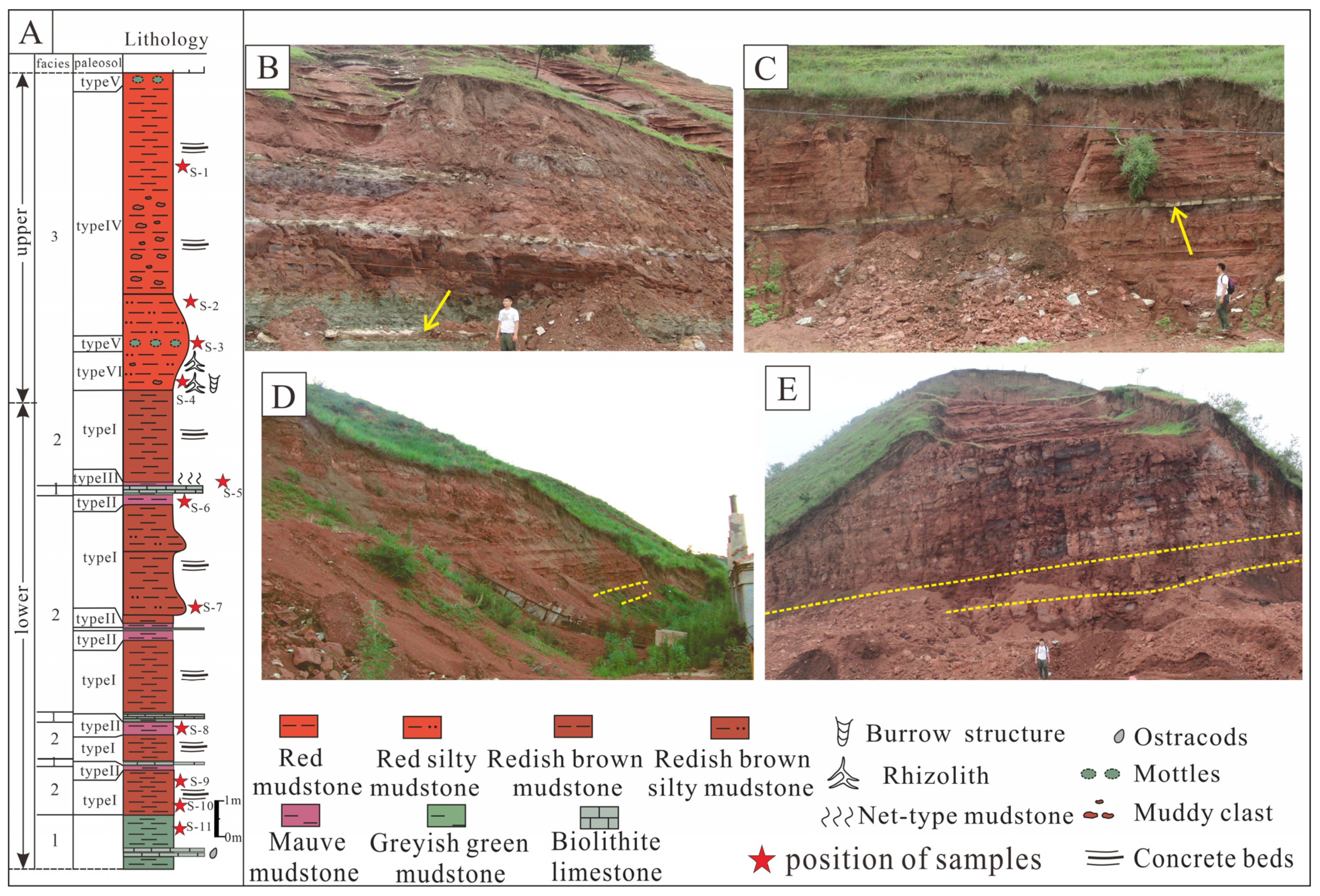
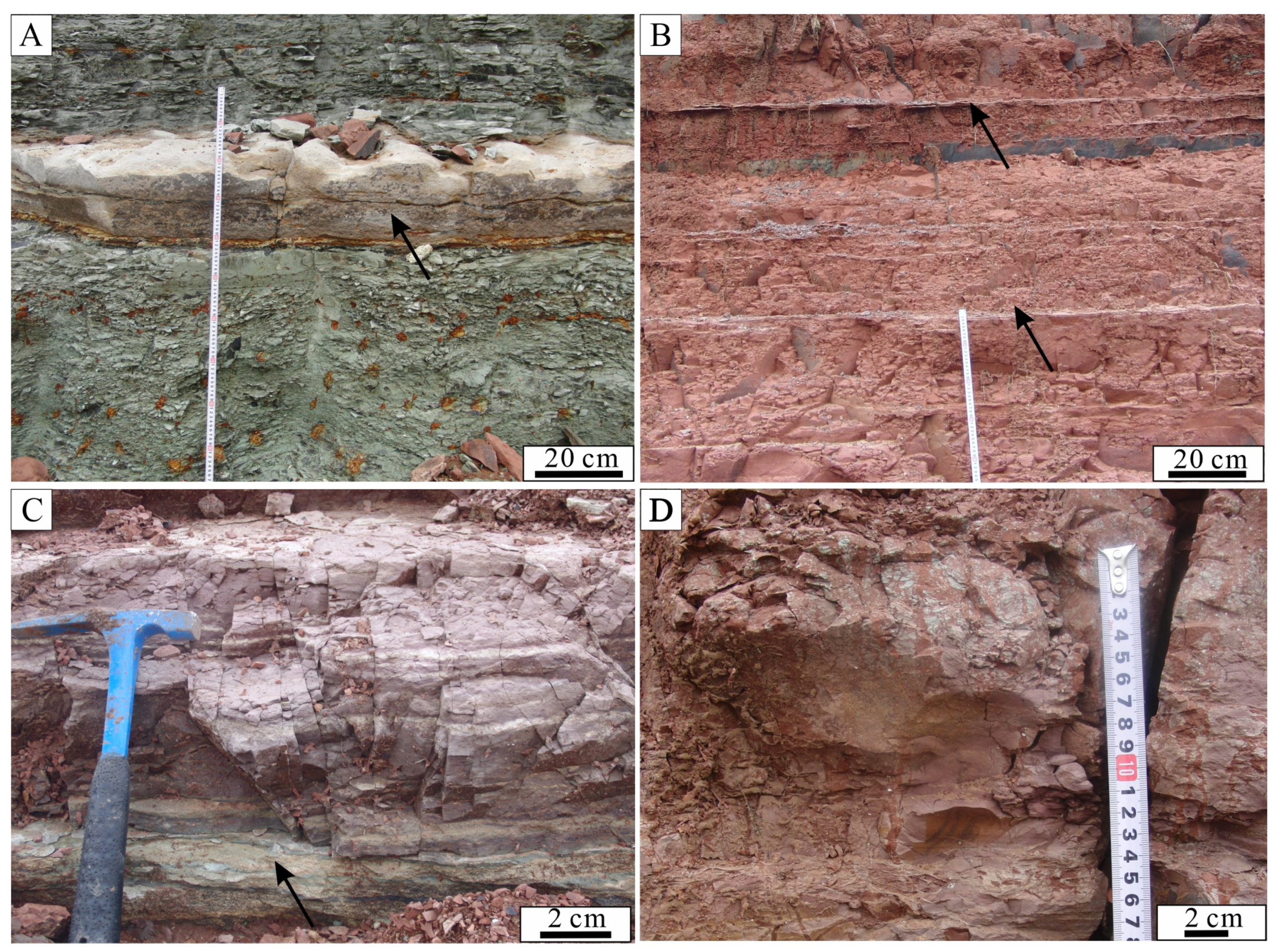
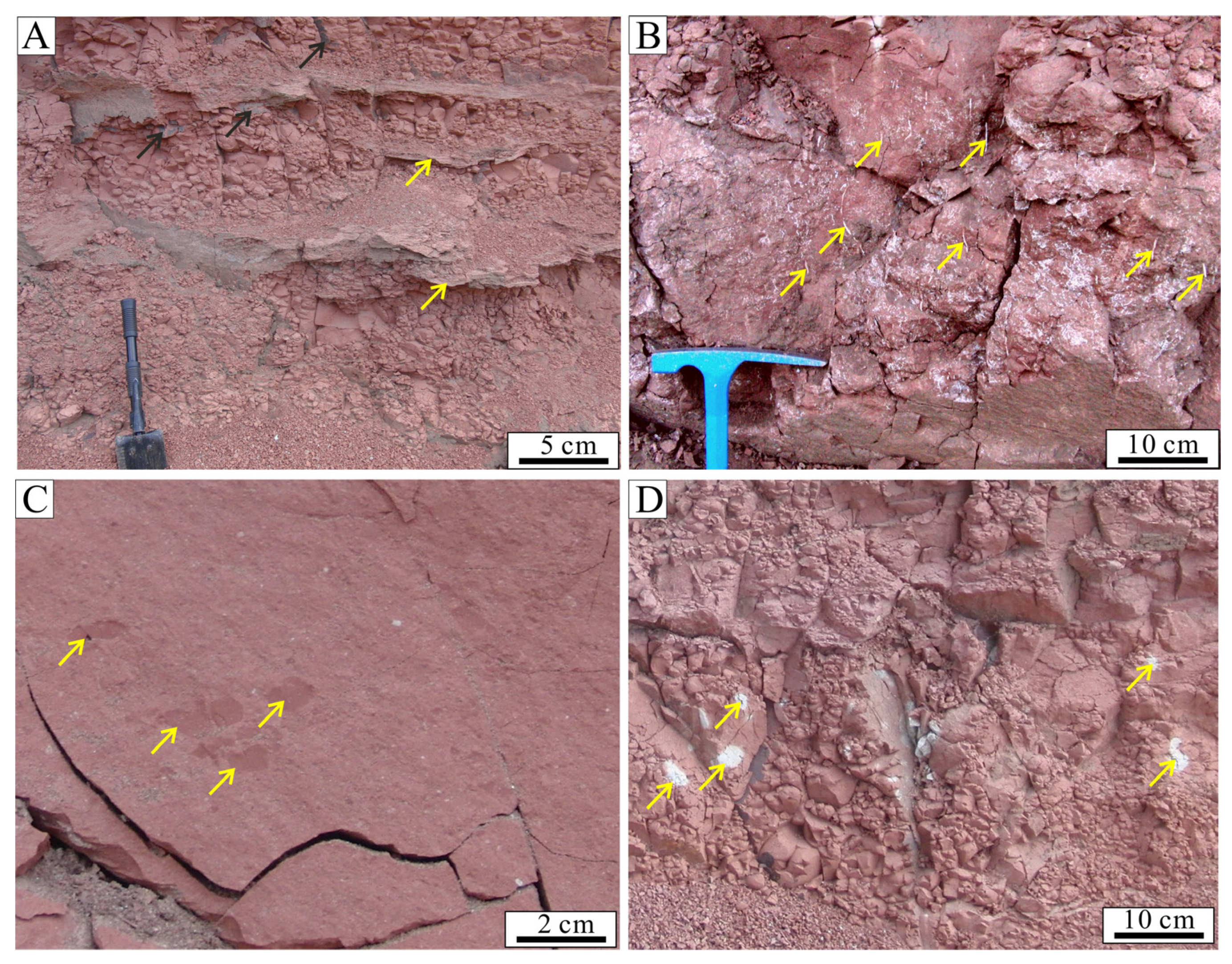

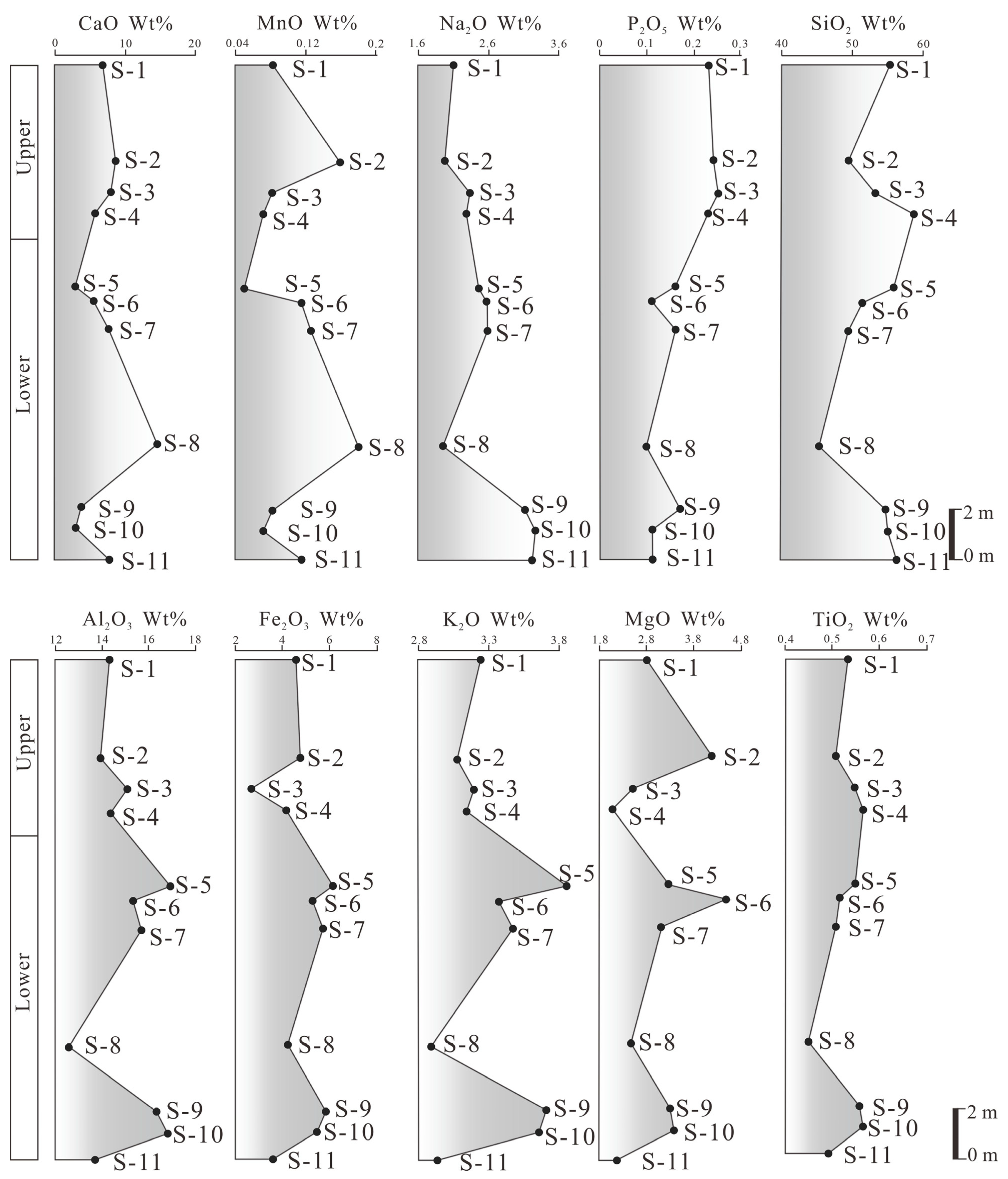


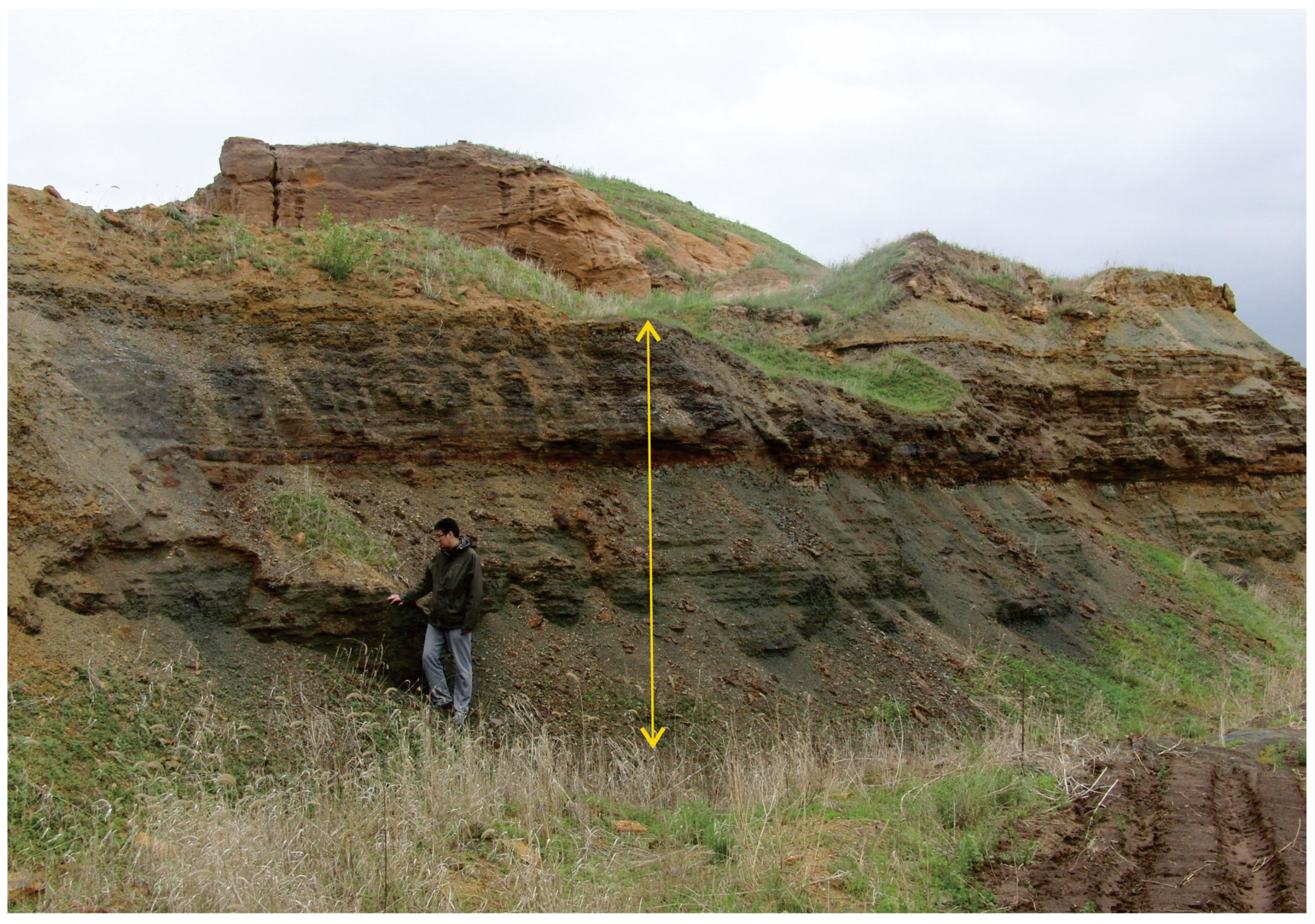

| Sample | Al2O3 | BaO | CaO | Cr2O3 | TFe2O3 | K2O | MgO | MnO | Na2O | P2O5 | SiO2 | SO3 | SrO | TiO2 | LOI | CIA-K* | MAP |
|---|---|---|---|---|---|---|---|---|---|---|---|---|---|---|---|---|---|
| S1 | 14.34 | 0.06 | 6.82 | <0.01 | 4.57 | 3.24 | 2.81 | 0.08 | 2.10 | 0.23 | 55.28 | 0.09 | 0.05 | 0.56 | 9.69 | 48.37 | 525.58 |
| S2 | 13.94 | 0.05 | 8.52 | <0.01 | 4.77 | 3.08 | 4.17 | 0.15 | 1.98 | 0.24 | 49.41 | 0.07 | 0.06 | 0.53 | 12.74 | 43.41 | 480.88 |
| S3 | 15.11 | 0.05 | 7.99 | 0.01 | 2.69 | 3.20 | 2.53 | 0.08 | 2.33 | 0.25 | 53.25 | 0.13 | 0.04 | 0.58 | 11.02 | 45.97 | 503.41 |
| S4 | 14.42 | 0.07 | 5.74 | 0.02 | 4.17 | 3.14 | 2.09 | 0.07 | 2.29 | 0.23 | 58.63 | 0.12 | 0.03 | 0.60 | 8.04 | 51.37 | 554.50 |
| S5 | 16.94 | 0.04 | 2.90 | <0.01 | 6.14 | 3.86 | 3.26 | 0.05 | 2.46 | 0.16 | 55.79 | 0.02 | 0.04 | 0.58 | 7.24 | 61.77 | 667.99 |
| S6 | 15.32 | 0.04 | 5.49 | <0.01 | 5.28 | 3.39 | 4.47 | 0.11 | 2.58 | 0.11 | 51.42 | 0.01 | 0.06 | 0.54 | 11.14 | 62.29 | 674.26 |
| S7 | 15.68 | 0.05 | 7.63 | <0.01 | 5.71 | 3.48 | 3.12 | 0.12 | 2.59 | 0.16 | 49.51 | 0.02 | 0.04 | 0.53 | 11.36 | 63.52 | 689.25 |
| S8 | 12.60 | 0.05 | 14.50 | 0.01 | 4.23 | 2.90 | 2.47 | 0.17 | 1.96 | 0.10 | 45.29 | 0.04 | 0.04 | 0.46 | 15.29 | 49.89 | 540.02 |
| S9 | 16.32 | 0.05 | 3.77 | <0.01 | 5.81 | 3.71 | 3.30 | 0.08 | 3.11 | 0.17 | 54.76 | 0.12 | 0.04 | 0.59 | 8.50 | 46.15 | 505.11 |
| S10 | 16.82 | 0.05 | 2.95 | <0.01 | 5.46 | 3.67 | 3.38 | 0.07 | 3.27 | 0.11 | 55.05 | 0.08 | 0.03 | 0.60 | 8.21 | 33.98 | 406.23 |
| S11 | 13.74 | 0.06 | 7.31 | <0.01 | 3.60 | 2.96 | 2.19 | 0.11 | 3.23 | 0.11 | 56.21 | 0.42 | 0.04 | 0.51 | 9.45 | 56.39 | - |
| Sample | Ba | Cu | Rb | Sr | Sr/Cu | Rb/Sr | Sr/Ba |
|---|---|---|---|---|---|---|---|
| S1 | 409 | 23.5 | 103.0 | 436 | 18.553 | 0.236 | 1.066 |
| S2 | 383 | 17.4 | 99.7 | 518 | 29.770 | 0.192 | 1.352 |
| S3 | 382 | 22.0 | 98.1 | 419 | 19.05 | 0.234 | 1.097 |
| S4 | 564 | 19.7 | 102.5 | 325 | 16.497 | 0.315 | 0.576 |
| S5 | 405 | 21.1 | 130.0 | 270 | 12.796 | 0.481 | 0.667 |
| S6 | 406 | 24.0 | 118.5 | 523 | 21.792 | 0.227 | 1.288 |
| S7 | 409 | 18.3 | 114.5 | 375 | 20.492 | 0.305 | 0.917 |
| S8 | 338 | 22.7 | 96.9 | 334 | 14.714 | 0.290 | 0.988 |
| S9 | 381 | 17.5 | 125.5 | 375 | 21.429 | 0.335 | 0.984 |
| S10 | 412 | 21.7 | 119.5 | 330 | 15.207 | 0.362 | 0.801 |
| S11 | 434 | 21.7 | 97.2 | 370 | 17.051 | 0.263 | 0.853 |
Publisher’s Note: MDPI stays neutral with regard to jurisdictional claims in published maps and institutional affiliations. |
© 2021 by the authors. Licensee MDPI, Basel, Switzerland. This article is an open access article distributed under the terms and conditions of the Creative Commons Attribution (CC BY) license (https://creativecommons.org/licenses/by/4.0/).
Share and Cite
Zhang, L.; Zhang, C.; Dou, L. Paleoenvironment Implication of Red Paleosols in a Late Cretaceous Continental Succession, Songliao Basin, NE China. Minerals 2021, 11, 993. https://doi.org/10.3390/min11090993
Zhang L, Zhang C, Dou L. Paleoenvironment Implication of Red Paleosols in a Late Cretaceous Continental Succession, Songliao Basin, NE China. Minerals. 2021; 11(9):993. https://doi.org/10.3390/min11090993
Chicago/Turabian StyleZhang, Li, Changmin Zhang, and Luxing Dou. 2021. "Paleoenvironment Implication of Red Paleosols in a Late Cretaceous Continental Succession, Songliao Basin, NE China" Minerals 11, no. 9: 993. https://doi.org/10.3390/min11090993





